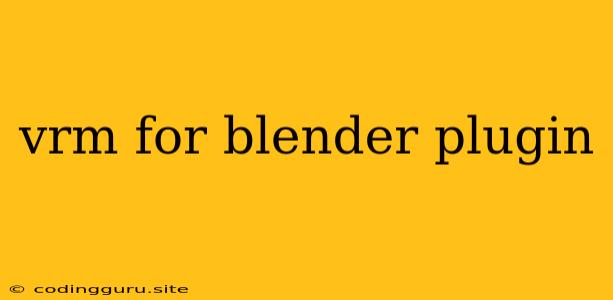VRM for Blender: Your Guide to Importing and Exporting 3D Models
Are you working on a 3D animation project and want to export your models in a format compatible with popular VR platforms? Look no further than VRM for Blender! This powerful plugin streamlines the process of importing and exporting 3D models in the VRM format, making it easier than ever to share your creations with a wider audience.
VRM (Virtual Reality Model) is a standardized file format specifically designed for 3D character models in virtual reality environments. It ensures compatibility across different VR platforms and applications, allowing for seamless integration of characters into various virtual experiences.
What is the VRM for Blender Plugin?
The VRM for Blender plugin is a free and open-source tool that seamlessly integrates with Blender, the industry-standard 3D modeling and animation software. It enables users to import and export VRM files directly within Blender, simplifying the workflow and eliminating the need for external tools.
Why Use VRM for Blender?
There are numerous reasons why the VRM for Blender plugin is an invaluable tool for 3D artists and animators:
- Simplified Workflow: The plugin eliminates the need for complex conversions and external applications, streamlining the process of importing and exporting VRM models.
- Compatibility: VRM is a widely adopted format for virtual reality applications, ensuring your models can be used in a variety of VR platforms.
- Enhanced Features: The plugin includes various features that enhance the creation and customization of VRM models, including support for avatar customization, animations, and materials.
- Open Source: The plugin is free to use and distribute, making it accessible to all 3D artists, regardless of budget or skill level.
Using the VRM for Blender Plugin
Installing the Plugin:
- Download the VRM for Blender plugin from the official repository.
- Install the plugin by extracting the downloaded zip file into the
scripts/addonsfolder within your Blender installation directory. - Enable the plugin within Blender's preferences under the "Add-ons" tab.
Importing VRM Models:
- Open Blender and navigate to File > Import > VRM.
- Select the desired VRM file from your computer.
- The model will be imported into your Blender scene, preserving its animations, materials, and other properties.
Exporting VRM Models:
- Make sure your model is ready for export, ensuring all necessary animations, materials, and textures are included.
- Navigate to File > Export > VRM.
- Choose a location to save your exported VRM file and click "Export."
Tips and Best Practices for VRM Modeling
- Rigging and Skinning: Ensure your model is properly rigged and skinned for smooth animations in virtual reality.
- Materials and Textures: Use high-quality materials and textures for a visually appealing and immersive experience.
- Animations: Create natural and engaging animations for your VRM model to enhance its interaction in VR environments.
- Optimize for Performance: Optimize your model's polygon count and texture size to ensure smooth performance in virtual reality.
Examples of VRM Models
- Virtual YouTubers: VRM is widely used in the Virtual YouTuber community, allowing creators to represent themselves in a virtual form.
- Virtual Assistants: VRM models can be used to create interactive virtual assistants for various tasks, such as providing information or assistance.
- Interactive Characters: VRM models are ideal for creating engaging and immersive interactive characters for VR games and experiences.
Conclusion
The VRM for Blender plugin is an essential tool for any 3D artist looking to create and share VRM models for use in virtual reality applications. Its intuitive interface, powerful features, and compatibility with Blender make it a seamless and efficient solution for working with VRM models.
With the VRM for Blender plugin, you can unlock a world of creative possibilities, bringing your 3D characters to life in virtual reality and sharing them with a wider audience.
